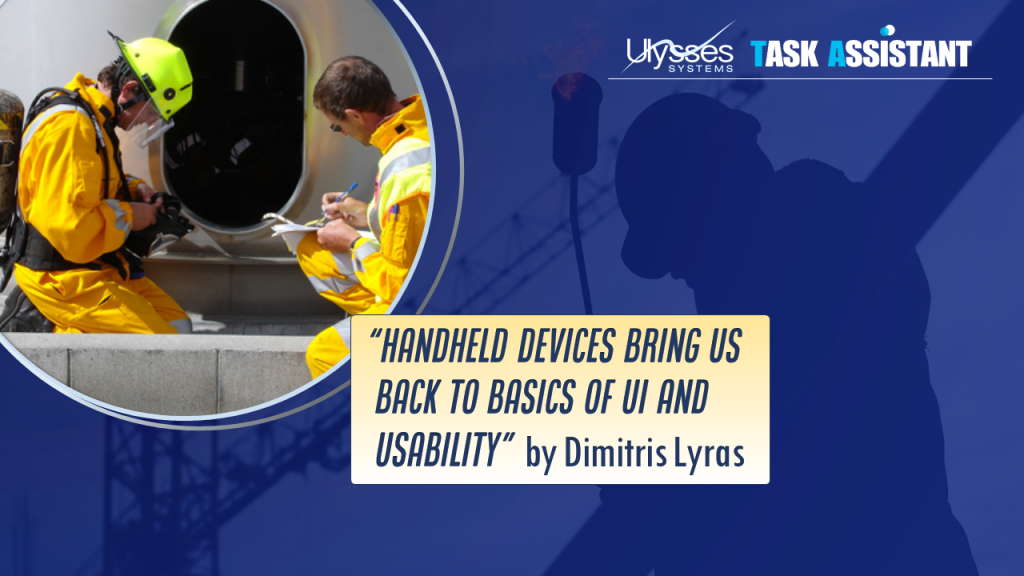
UI Basics
Handheld devices bring us back
to the basics of UI and Usability
an article by Dimitris Lyras
In this article about User Interface design, Dimitris Lyras, discusses how handheld devices perforce bring us back to the basics of UI and usability. The article was first published as a paper for the CHIGreece Conference, November 26,2021, in the context of Usability in Human and Computer Interaction.
UI and Usability
What if you don’t use the basics of UI and usability?
The smaller the window the harder it is to get an overall view. It follows that the less space you have, the harder it is to be oriented to what the options are, and to which one you are looking at, at any point on time.
Once UI design has achieved consistency of orientation, the rest is understanding and accommodating exactly what the user expects.
Let’s start with articulation, while being aware that articulation must be consistent with user expectations.
User Expectations
To overcome the UI and usability challenge, you need to meet user expectations in a particular application.
The need, therefore, is for an intuitive overview of the options that is consistent for the variety of application tasks. Applications that navigate in different ways for each feature, without consistent articulation, are very hard for users to learn. If, moreover, users handle many handheld applications this becomes a showstopper.
The world around the application needs to be understood
So, how do you meet user expectations and how do you articulate consistently?
This depends on the application. Because a navigation device on a car is not the same as a reporting application for inspections on a ship. This means, the world around the application needs to be understood.
Let’s say, for example, that the world is about co-ordinating work on a ship. What are the ways that people expect to find features used in co-ordination? Primarily, they expect to find them grouped in ways that people naturally use on ships. Because there is a pattern, and this pattern is based on what shipping people are trying to achieve. Finally, there is a generic part to the grouping and then a ship and job specific part.
Goals that converge
Every computer scientist may know that people have goals and that goals converge. That there are processes assigned to goals and these processes have steps. And that people are assigned steps in these processes to achieve common goals. Also, that many processes have common components that need to be accessed from many use cases. Further, these processes are most often quite general and then break down into specific processes that have different outcomes although the processes are the same. Finally, that there are many process variations, and each process can have a different path depending on the circumstances of the process.
But knowing how goals converge is not enough. Because the entire software platform must articulate in a way to satisfy usability. Otherwise, the navigation will be inconsistent.
For example
For example, each user has a set of steps in several processes. A safety officer may report on a finding on deck and prepare an enclosed space entry form. But the second officer does not approve the enclosed space entry form nor investigate the finding. However, unless the system articulates properly the safety officer may be confronted with options far beyond his responsibilities. If the system does not break down the processes so that navigation applies to the person using the device and not all other people as well, it will be impossible to use.
User paths
Similarly, the system must delineate the paths the user is expected to take in the process step and its circumstances. If not, the user is confronted with options that do not apply. Or with choices at inopportune times, when the user expects something else.
We mentioned earlier that the entire software platform has to articulate in a way to satisfy usability. Chiefly because, in order to achieve a reporting goal, user paths may involve steps belonging to different processes.
Interconnected Applications
Consequently, these considerations need to apply to all features that come under a group of enterprise interconnected applications. And the articulation for co-ordination software and other breakdowns that must work on handheld devices differs depending on the user’s world.
We can, therefore, conclude that there is a need to articulate related processes in a consistent way. They also need to be worked out throughout the system of interconnected applications. Furthermore the system, to understand user expectations, must cover much more than the immediate interactions.
